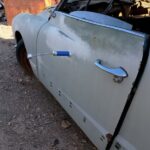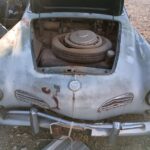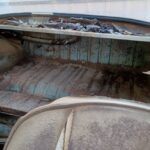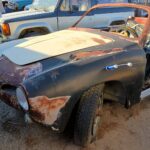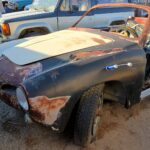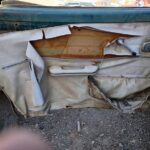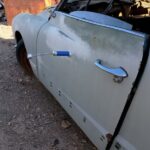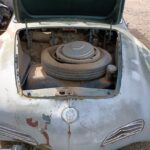| Volkswagen Types 14, 34, and 145 | |
|---|---|

1962 Type 14 VW Karmann Ghia
|
|
| Overview | |
| Manufacturer | Volkswagen |
| Production | Germany Type 14: 1955–1974 Type 34: 1961/1962–1969 445,238 total units built: [1] Coupé: 364,401 (Type 14 and 34) Cabriolet: 80,837 (all Type 14)Brazil Type 14: 1962–1975 TC (Touring Coupé): 1972–197541,689 total units built:[2] Coupé: 23,393 Cabriolet: 177 TC (Touring Coupé): 18,119 |
| Assembly | West Germany: Osnabrück[3] Brazil: São Bernardo do Campo(Volkswagen do Brasil) |
| Designer | Carrozzeria Ghia: Luigi Segre and Felice Mario Boano and others; 1972 update by Sergio Sartorelli |
| Body and chassis | |
| Class | Sports car (S) |
| Body style | 2-door convertible 2-door coupé |
| Layout | RR layout |
| Related | Volkswagen Beetle Volkswagen Type 3 Puma GT |
| Powertrain | |
| Engine | 1200 cc, 1300 cc, 1500 cc, or 1600 cc flat-4 |
| Chronology | |
| Successor | |
| Volkswagen Types 14, 34, and 145 | |
|---|---|

1962 Type 14 VW Karmann Ghia
|
|
| Overview | |
| Manufacturer | Volkswagen |
| Production | Germany Type 14: 1955–1974 Type 34: 1961/1962–1969 445,238 total units built: [1] Coupé: 364,401 (Type 14 and 34) Cabriolet: 80,837 (all Type 14)Brazil Type 14: 1962–1975 TC (Touring Coupé): 1972–197541,689 total units built:[2] Coupé: 23,393 Cabriolet: 177 TC (Touring Coupé): 18,119 |
| Assembly | West Germany: Osnabrück[3] Brazil: São Bernardo do Campo(Volkswagen do Brasil) |
| Designer | Carrozzeria Ghia: Luigi Segre and Felice Mario Boano and others; 1972 update by Sergio Sartorelli |
| Body and chassis | |
| Class | Sports car (S) |
| Body style | 2-door convertible 2-door coupé |
| Layout | RR layout |
| Related | Volkswagen Beetle Volkswagen Type 3 Puma GT |
| Powertrain | |
| Engine | 1200 cc, 1300 cc, 1500 cc, or 1600 cc flat-4 |
| Chronology | |
| Successor | |
The Volkswagen Karmann Ghia are a family of three overlapping sporty Volkswagen model series, marketed in 2+2 coupe (1955–1975) and 2+2 convertible (1957–1975) body styles, though German production ended one year before that in Brazil. Internally designated the Type 14 (1955–1975), the Type 34 (1962–1969), and the Type 145 TC(1972–1975; Brazil), the Karmann Ghia cars combined the floorpans and mechanicals of the Type 1 / Beetle or Type 3 ‘ponton’ models with styling by Italy’s Carrozzeria Ghia, and hand-built bodywork by German coachbuilding house Karmann.[4]
The 1955 Type 14 Karmann Ghia was just the second Volkswagen passenger car ever produced, after the Beetle, and launched six years before the Type 3 notchbacks, fastbacks and Variants (squarebacks). They were faster and more expensive than the Beetle, but very cramped in the back, despite their wider, postwar and nearly slabsided body design. Two years later, in 1957, a convertible was added.
In 1961, the Karmann Ghia briefly lost its title of fastest Volkswagen, upon launch of the more powerful 1500cc Type 3 models, but later that year, Volkswagen, Ghia, and Karmann presented an all new Karmann Ghia – Type 34, using the Type 3’s floorpan and 1500cc powertrain. Made from 1962 to 1969, this had both new, more modern, angular and roomier bodywork; and a new, more luxurious interior, making it substantially more expensive than all other VW passenger cars. Additionally, the Type 34 was one of the world’s first cars with a power operated steel sunroof option. The Type 34 Karmann Ghia thus became VW’s range-topper again – costing up to twice the price of a Beetle – while the cheaper Type 14 remained in production. Only the latter offered a convertible.
Failure to offer the Type 34 in the United States – the Karmann Ghia’s most important market – combined with high pricing elsewhere likely contributed to limited sales, and after the type 14 also received the 1500cc engine in 1967, production of Type 34s was ended during 1969. Volkswagen of Brazil nevertheless looked for an alternative in its market segment, and so Carrozzeria Ghia was again commissioned, to design a third Karmann Ghia model, for the South American market, the Karmann Ghia TC (Touring Coupé), made in Brazil from 1972–1975. The result was a stylish, rakish fastback that offered good interior space for a 2+2 car.
For its final model year, the vestigial rear seat in the Type 14 was discontinued for North American models, as it lacked provisions for seat belts; all Karmann Ghias for 1974 were marketed strictly as two-seaters.
More than 445,000[3] Karmann Ghias were produced in Germany over the car’s production life, not including the Type 34 variant. Volkswagen do Brasil (Volkswagen Brasil) produced 41,600 Type 34s in Brazil for South America between 1962 and 1975.
Long noted for its exterior styling, the Karmann Ghia was designed with input from numerous individuals at Carrozzeria Ghia and was strongly influenced by Virgil Exner‘s work, though all of its designers passed without a definitive individual styling attribution.
Genesis[edit]
Three companies and numerous individuals came together in the history of the Karmann Ghia. In the early 1950s, Volkswagen was producing its Volkswagen Beetle, and as postwar standards of living increased, executives at Volkswagen were at least receptive to adding a halo model to its range, if not actively seeking an additional model. Luigi Segre was committed to expanding the international reputation of Carrozzeria Ghia. And Wilhelm Karmann had taken over his family coachbuilding firm Karmann and was eager to augment his contracts building Volkswagen’s convertible models.
Wilhelm Karmann and Luigi Segre often encountered each other at international automobile shows, and after an initial discussion prompted by Wilhelm Karmann, Segre secretly obtained[5] a Volkswagen Beetle to use as a basis for a prototype[6] – Beetles were difficult to come by and Gian Paolo, Mario Boano’s son, purchased one in Paris and drove it back to Turin.[7] Ghia customized its platform, designed the initial prototype and in five months constructed the model. Segre secretly presented the model to Wilhelm Karmann one year after the initial discussion — late in 1953, in Paris, at the Societé France Motors factories (Volkswagen’s dealership for France and the exclusive European dealer of Ghia-built Chrysler models).[8] When Wilhelm Karmann saw the coupé, Karmann said, “I’d like to build that!”[9] As the head of Ghia, Segre singularly directed the project through conception and prototyping, delivering a feasible project that Willhelm Karmann both wanted to and could practically build — the project Wilhelm Karmann would in turn present to Volkswagen.
The styling of the vehicle, however, integrated work by Segre as well as Mario Boano, Sergio Coggiola and Giovanni Savonuzzi — and at various times they each took credit for the design.[10] Furthermore, the design bore striking styling similarities to Virgil Exner‘s Chrysler D’Elegance and K-310 concepts, which Ghia had been tasked with prototyping — and which in turn reflected numerous cues and themes developed previously by Mario Boano.[5] According to Virgil Exner’s son, Virgil M. Exner Jr., Giovanni Savonuzzi was tasked with scaling down the full-sized d’Elegance, replacing “the Chrysler’s egg-crate grille with a gentle, boat-like prow.[11] Exner Jr. is further quoted as saying that the Karmann Ghia “was a direct, intentional swipe off the Chrysler D’Elegance. Giovanni Savonuzzi was the engineer and designer who downsized the D’Elegance and made the Karmann Ghia out of it. Nobody minded it. It was wonderful.”[7]
The precise styling responsibilities were not well-documented at the time, before the passing of the various designers,[5] further complicated by the overlapping work of the key players. A definitive individual attribution on Karmann Ghia’s styling was never made.[5]
Segre and Virgil Exner became close professionally and personally, eventually traveling Europe together.[12]Peter Grist wrote in his 2007 Exner biography that when Exner in 1955 eventually saw the Karmann Ghia, which cribbed heavily from his Chrysler d’Elegance, “he was pleased with the outcome and glad that one of his designs had made it into large-scale production.”[13] Chris Voss, a stylist in Exner’s office, reported in 1993, that Exner considered the Karmann Ghia the ultimate form of flattery.[10] Segre in turn sent Exner the first production Karmann Ghia imported into the state of Michigan, in gratitude.[14]
After Volkswagen approved the design in November 1953, the Karmann Ghia debuted (at the 1955 Paris and Frankfurt[11] auto shows and at the Kasino Hotel in Westfalia, Germany, on July 14, 1955)[15] and went into production, first at Ghia[9] and then in Osnabrück — ultimately to reach a production over 445,000, running 19 years virtually unchanged.[3]
- Early Karmann-Ghia models









